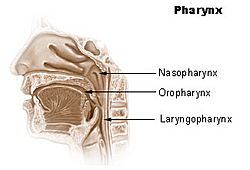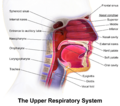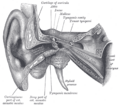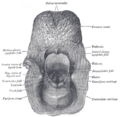Pharynx facts for kids
Quick facts for kids Pharynx |
|
|---|---|
 |
|
| Head and inner neck | |
 |
|
| Pharynx | |
| Latin | pharynx |
| Artery | pharyngeal branches of ascending pharyngeal artery, ascending palatine, descending palatine, pharyngeal branches of inferior thyroid |
| Vein | pharyngeal plexus |
| Nerve | pharyngeal plexus, maxillary nerve, mandibular nerve |
The pharynx (plural: pharynges) is the part of the throat behind the mouth and nasal cavity, and above the esophagus and larynx – the tubes going down to the stomach and the lungs. It is found in vertebrates and invertebrates, though its structure varies across species.
In humans, the pharynx is part of the digestive system and the conducting zone of the respiratory system. (The conducting zone—which also includes the nostrils of the nose, the larynx, trachea, bronchi, and bronchioles—filters, warms and moistens air and conducts it into the lungs). The human pharynx is conventionally divided into three sections: the nasopharynx, oropharynx, and laryngopharynx. It is also important in vocalization.
In humans, two sets of pharyngeal muscles form the pharynx and determine the shape of its lumen. They are arranged as an inner layer of longitudinal muscles and an outer circular layer.s
Images for kids
-
Pharynx of the flatworm Prorhynchus fontinalis
-
Pharynx of the flatworm Platydemus manokwari visible as the worm feeds on a snail.
-
Longitudinal section through the roundworm Caenorhabditis elegans showing the position of the pharynx in the animal body.
-
Microscopic cross section through the pharynx of a larva from an unknown lamprey species.
See also
 In Spanish: Faringe para niños
In Spanish: Faringe para niños











